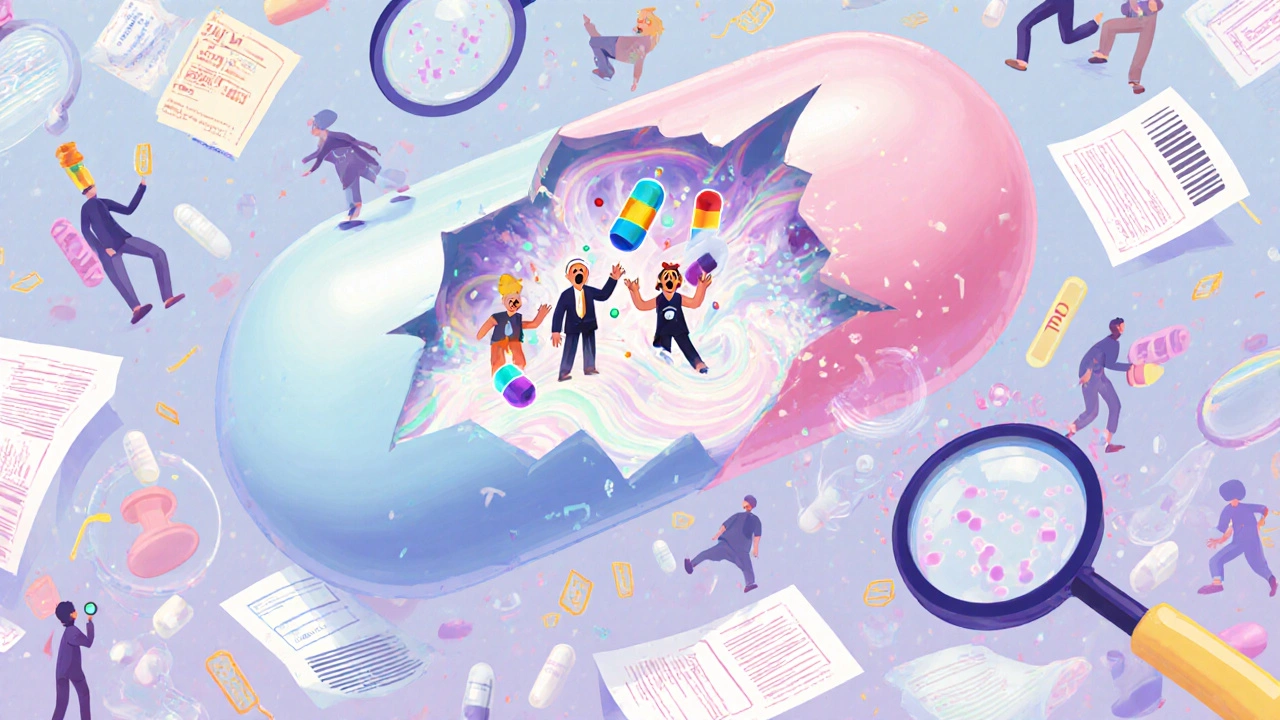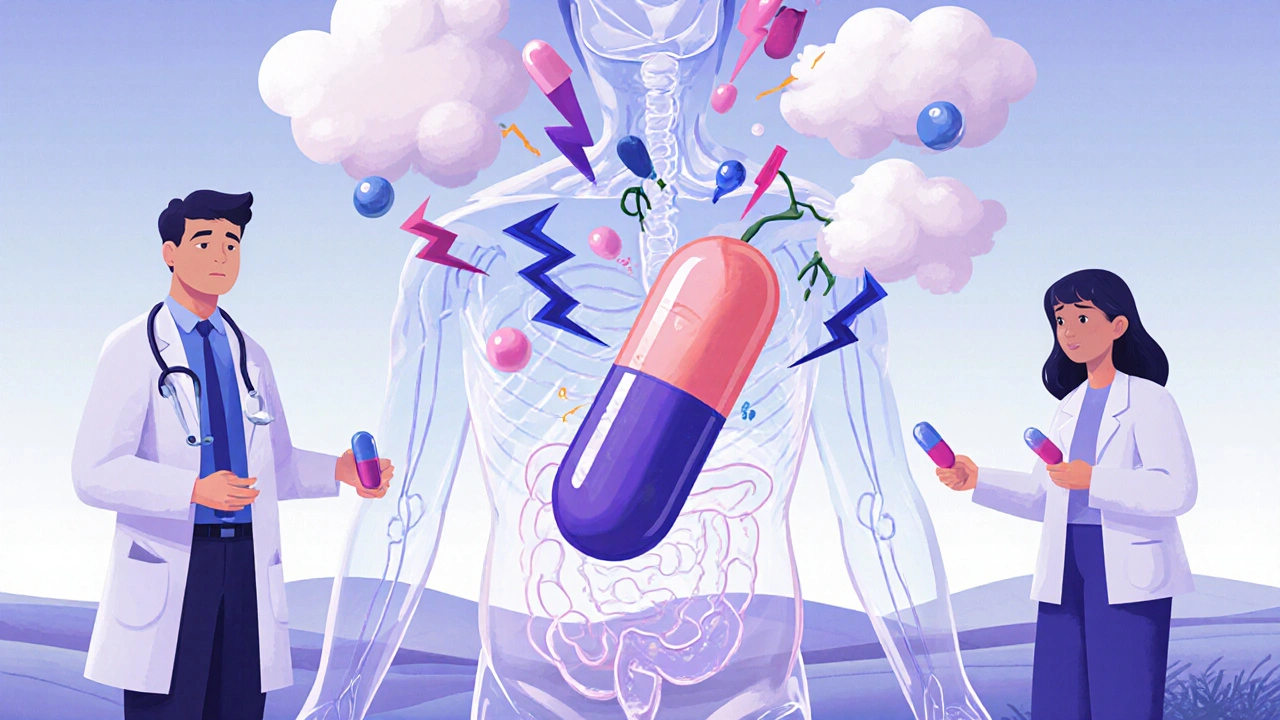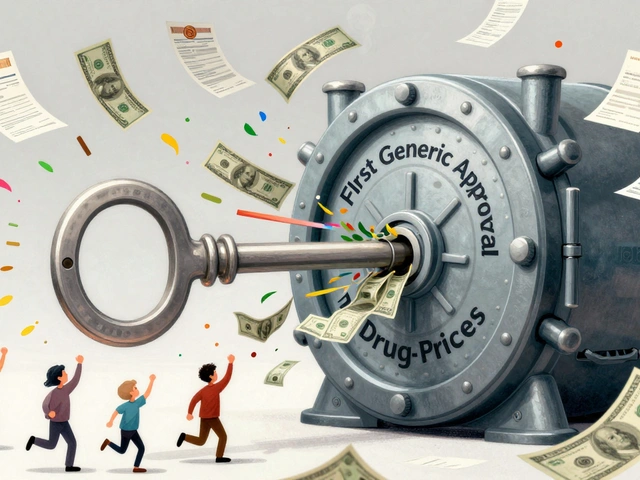
Most people assume that if two pills have the same active ingredient, they work the same way. That’s true for the drug’s main effect-but not always for how your body reacts to it. The hidden difference? The excipients. These are the so-called "inactive" ingredients in your medication: fillers, dyes, preservatives, and binders. They don’t treat your condition. But for some people, they can make you sick.
What Exactly Are Excipients?
Excipients are the non-drug parts of a pill, capsule, or liquid. Think of them as the scaffolding that holds the medicine together. They help the drug dissolve properly, last longer on the shelf, taste better, or be easier to swallow. Common ones include lactose (a milk sugar), corn starch, magnesium stearate, cellulose, FD&C dyes like Yellow #5 or Blue #2, and preservatives like parabens or sulfites. The FDA defines them as ingredients "not intended to exert a therapeutic effect." But that label is misleading. Just because they don’t target your disease doesn’t mean they’re harmless. A 2019 study analyzing over 42,000 oral medications found that 90.2% of them contained at least one ingredient linked to allergic reactions or intolerances. The average pill had 8.8 excipients. Some of the most commonly prescribed drugs had more than 80 different inactive ingredients across their various generic versions.Why Do Generic Pills Have Different Excipients?
When a brand-name drug’s patent expires, other companies can make generics. The FDA requires these generics to match the brand’s active ingredient in strength, dosage form, and bioequivalence-meaning they deliver the same amount of medicine into your bloodstream at a similar rate. But the law doesn’t require them to use the same fillers or dyes. That’s why two pills labeled "levothyroxine 75 mcg" can look completely different. One might use lactose and titanium dioxide. Another might use mannitol and iron oxide. Both are approved. Both are legal. But for someone with lactose intolerance or a dye sensitivity, one could cause bloating, diarrhea, or hives-and the other won’t. A 2021 study found that 73.5% of pharmacists had patients report side effects they believed were tied to switching between brand and generic versions. These weren’t vague complaints. People described sudden stomach cramps, rashes, or headaches that disappeared after switching back.The Real Risks: Lactose, Dyes, and Preservatives
Not all excipients are equal in risk. Some are far more likely to cause problems:- Lactose: Found in 40-60% of oral tablets. Even small amounts-1 to 2 grams-can trigger symptoms in sensitive people. That’s less than a teaspoon of milk. Symptoms: bloating, gas, nausea, diarrhea. For someone with severe intolerance, even a single daily pill can be enough to disrupt their gut for days.
- Artificial colors: Yellow #5 (tartrazine) and Blue #2 (indigotine) are linked to allergic reactions, hives, and asthma flare-ups in susceptible individuals. One Reddit user reported severe GI distress after switching from brand Synthroid to a generic containing FD&C Blue #2. Symptoms vanished after switching to a dye-free version.
- Parabens and sulfites: Used as preservatives in liquids and injectables. Can cause skin rashes, respiratory issues, or anaphylaxis in rare cases. People with asthma or sulfite sensitivity need to check labels carefully.
- Gluten: While not common, some generics use wheat starch as a filler. For people with celiac disease, even trace amounts can cause intestinal damage.

Why This Matters More Than You Think
Generics make up 90% of all prescriptions filled in the U.S. That’s because they’re 80-85% cheaper than brand-name drugs. Cost savings are huge. But when patients switch between generic manufacturers-or from brand to generic-they often don’t realize they’re getting a new chemical cocktail. The problem gets worse in chronic conditions. Think thyroid disease, epilepsy, or depression. Small changes in absorption caused by different solubilizers or binders can lead to under- or over-treatment. One patient might feel fine on Generic A, but switch to Generic B and suddenly feel foggy, anxious, or fatigued. Doctors often blame it on "noncompliance" or "psychological factors"-when it’s actually the excipients. A 2022 survey of 1,245 independent pharmacists found that 68.3% had patients report adverse reactions after switching generics. Yet only 22.7% of providers documented these reactions in medical records. That means most cases go untracked. No one knows how widespread this really is.What You Can Do: A Practical Guide
You don’t need to avoid generics. But you do need to be smarter about them.- Track your symptoms. If you start feeling worse after switching medications, write it down. When did it start? What changed? Did you switch from brand to generic? From one generic to another?
- Check the ingredients. Use the FDA’s Inactive Ingredient Database (IID) or the Pillbox tool from the National Library of Medicine. Type in the drug name and manufacturer. You’ll see every excipient listed.
- Ask your pharmacist. Don’t assume all generics are the same. Ask: "Is this version free of lactose? Does it contain dyes?" Many pharmacies can order dye-free or lactose-free versions if they’re available.
- Request a specific manufacturer. If one generic works for you, stick with it. Some pharmacies allow you to request a specific brand of generic. You might pay a little more, but you’ll avoid unpredictable reactions.
- Document your intolerance. If you react to an excipient, tell your doctor. Ask them to note it in your chart: "Allergic to FD&C Blue #2" or "Lactose intolerant-avoid lactose-containing formulations." This prevents future switches from causing problems.

The Future: Personalized Excipients
The industry is starting to wake up. In 2023, the FDA launched the "Excipient Safety Modernization Initiative" to include patient-reported data in its safety database. MIT developed an AI tool that predicts individual excipient tolerance based on genetic markers. By 2025, the FDA plans to require full excipient disclosure in electronic prescriptions-so your doctor will see exactly what’s in the pill before they write it. Meanwhile, the market for specialty generics-lactose-free, gluten-free, dye-free-is growing fast. It hit $18.7 billion in 2022 and is rising at nearly 7% per year. Pharmaceutical companies are now building databases to track excipient sensitivities. Some hospitals have formal protocols for managing these reactions. This isn’t just about allergies. It’s about precision medicine. Just like we now test for drug metabolism genes before prescribing certain antidepressants, we’re starting to realize that excipient profiles matter too. Your body doesn’t just react to the drug-it reacts to everything around it.Final Thought: Inactive Doesn’t Mean Inert
The word "inactive" is a lie. It makes people think these ingredients are harmless. But if you’re sensitive, they’re anything but. A pill isn’t just a chemical. It’s a full formulation-and every component plays a role in how your body handles it. You have the right to know what’s in your medicine. You have the right to ask for a version that won’t make you sick. And you have the right to expect your prescriber and pharmacist to take these concerns seriously. The next time you get a generic refill, don’t just swallow it. Look it up. Ask questions. Pay attention to how you feel. Your body is telling you something. Listen.Are all generic medications the same in terms of ingredients?
No. While generics must contain the same active ingredient and meet bioequivalence standards, they can-and often do-use different fillers, dyes, binders, and preservatives. Two pills with the same drug name can have completely different excipient profiles, which can affect tolerance in sensitive individuals.
Can excipients cause real side effects?
Yes. Common excipients like lactose, artificial colors (Yellow #5, Blue #2), parabens, and sulfites have been linked to allergic reactions, gastrointestinal distress, skin rashes, and asthma symptoms in sensitive people. A 2019 study found that over 90% of oral medications contain at least one ingredient associated with adverse reactions.
How do I find out what excipients are in my medication?
Check the FDA’s Inactive Ingredient Database (IID) or use the Pillbox tool from the National Library of Medicine. You can search by drug name and manufacturer. The drug’s packaging or patient information leaflet may also list ingredients, but generics often don’t include full details-so you may need to contact the manufacturer directly.
What should I do if I think an excipient is making me sick?
Track your symptoms and when they started. Note any recent switches in medication. Talk to your pharmacist and doctor. Ask for a version without the suspected excipient-like a lactose-free or dye-free alternative. Request that your intolerance be documented in your medical record to prevent future issues.
Are there safer alternatives to standard generics?
Yes. Specialty generics with lactose-free, gluten-free, or dye-free formulations are increasingly available. The market for these products is growing rapidly, with over 40% of major pharmaceutical companies now maintaining excipient sensitivity databases. Ask your pharmacist if a specialty version is available for your medication.






12 Comments
OMG I had no idea lactose was in so many pills!! I’ve been getting terrible bloating for months and thought it was just my diet. Just checked my levothyroxine-yep, lactose listed. Switched to a dye-free, lactose-free version last week and my gut is finally chillin’ 😌 Thank you for this post, you just saved my life.
/p>Bro this is all just Big Pharma’s way to make you pay more. The FDA? They’re bought. Lactose? It’s in everything because they want you dependent. They don’t care if you get bloated-they care about the stock price. Wake up. The real drug is fear.
/p>Why are we letting foreigners make our meds? I bet 90% of these ‘inactive’ ingredients are from China. We don’t even know what’s in them. This is why America’s health is falling. We need to make pills here. Made in USA or bust.
/p>So let me get this straight-you’re mad because your $0.50 generic pill has a dye in it? Meanwhile, your Starbucks oat milk latte has 17 ingredients you can’t pronounce. Pick your poison, champ.
/p>As a Nigerian woman who’s been on antiretrovirals for 12 years, I can tell you-this is global. In Lagos, we get generics from India, Brazil, even South Africa. Some make me dizzy. Others don’t. I keep a little notebook: ‘Blue pill = headache. White pill = fine.’ Knowledge is power. And yes, your body is talking. Listen. 🙏
/p>This hits deep. 🫂 I used to think ‘inactive’ meant ‘harmless.’ But my body’s been screaming for years-rashes, brain fog, fatigue-and no doctor listened. Then I found out my antidepressant had FD&C Yellow #5. Switched versions. Symptoms vanished. It’s not ‘all in your head.’ It’s science. And we’re finally catching up. Thank you for naming it.
/p>Love this! I always tell my patients to check the label-even if it’s tiny. I’ve had people cry because they finally understood why they felt awful after switching. You’re right: it’s not about being anti-generic. It’s about being pro-safety. 🙌
/p>If you can’t handle a little lactose or dye, maybe you shouldn’t be on medication at all. People these days treat pills like gourmet food. Grow up.
/p>Bro I just checked my blood pressure med-contains titanium dioxide. I thought that was in paint. 😳 Should I be scared? Also, can I get a version without it? My cousin in Kerala says he switched and now he’s fine.
/p>Wait… so you’re saying the FDA lets companies put whatever they want in pills as long as it’s not the drug? And you’re shocked? Honey, they let companies put aspartame in diet soda. This is Tuesday.
/p>Let’s not romanticize this. The fact that we’re even having this conversation means the system is broken. We’ve normalized ignorance. You shouldn’t need a PhD in pharmacology just to know if your pill will make you sick. And yet here we are. The word ‘inactive’ is a linguistic trap-and we’ve all fallen for it.
/p>So? Just take the brand. Done.
/p>